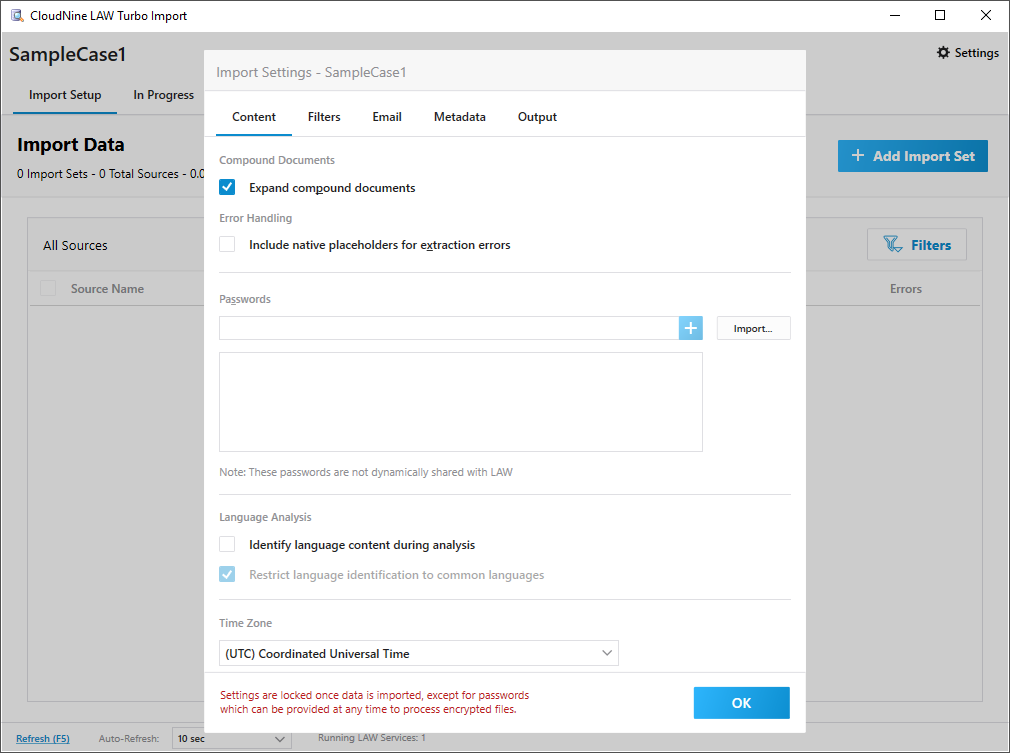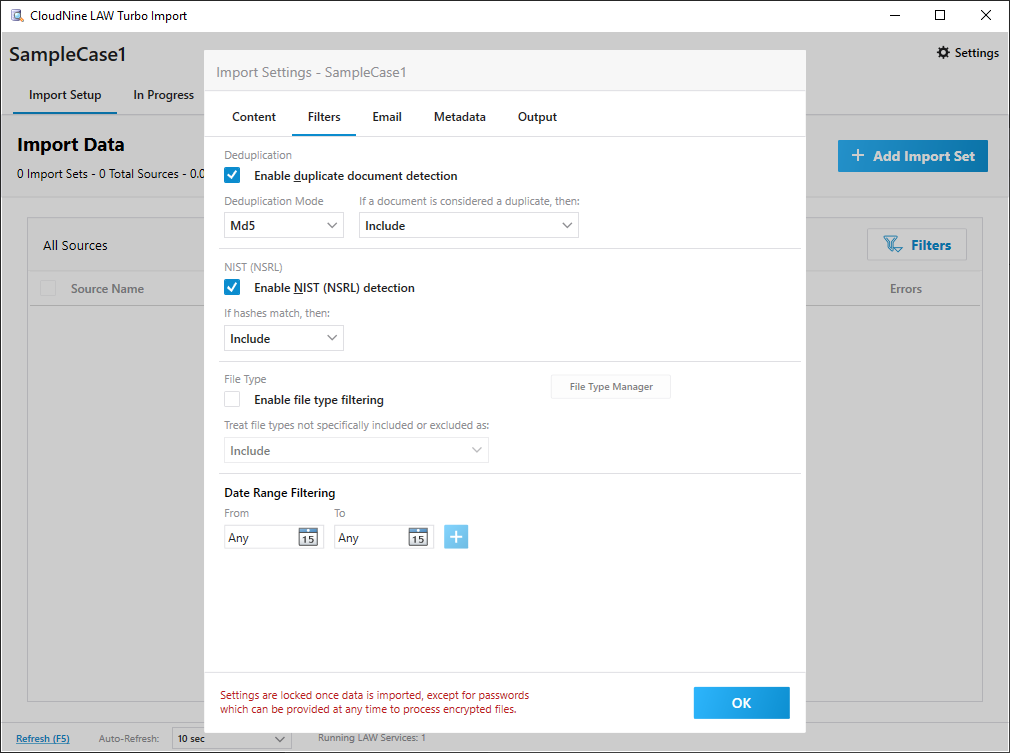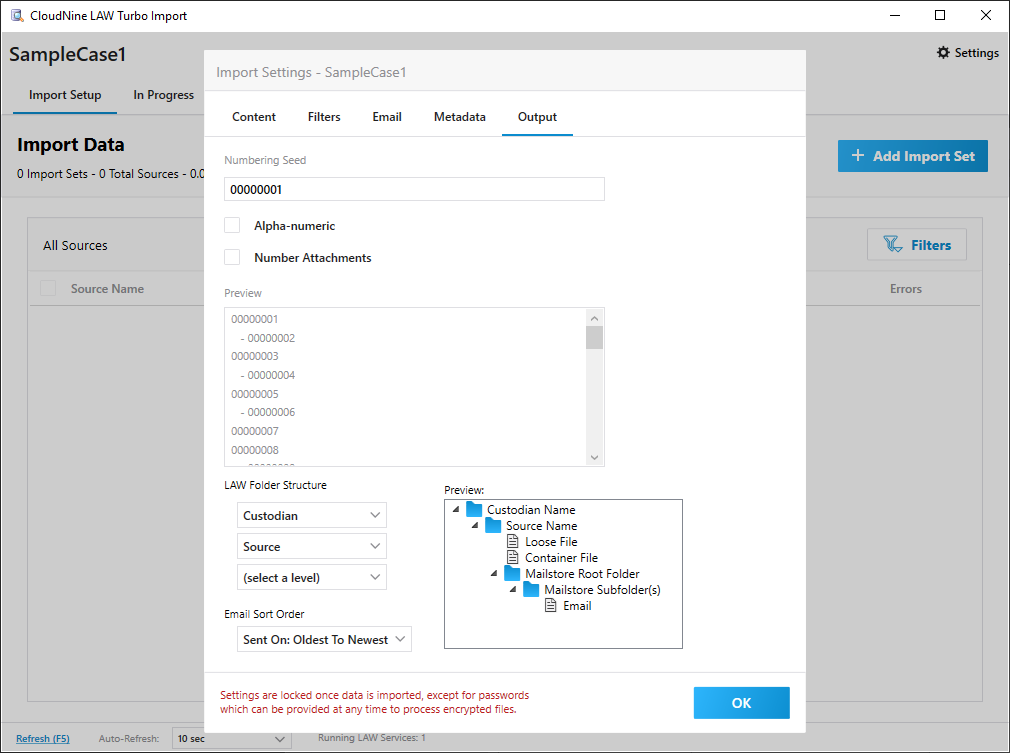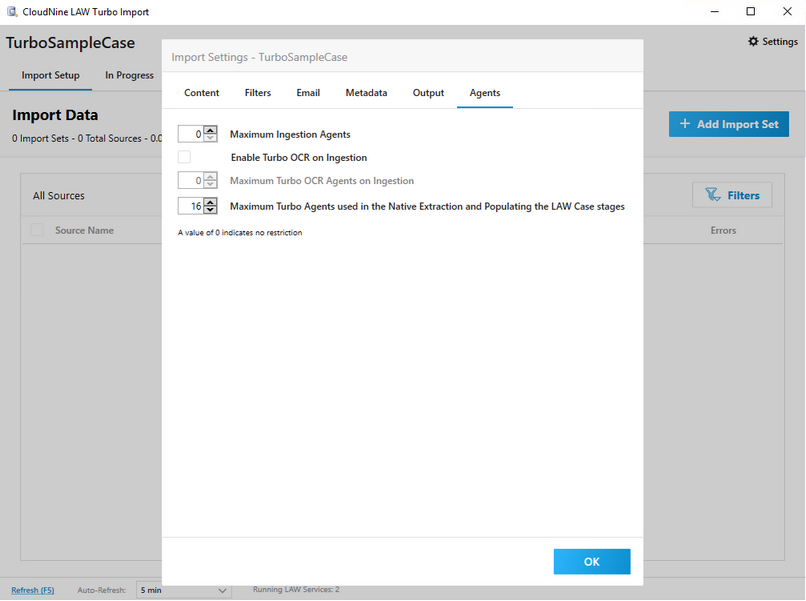Buttons for Subtopics ![]() Return to Topic
Return to Topic ![]()
 Opening and Configuring Turbo Import
Opening and Configuring Turbo Import
1.Start from the Menu of the Main User Interface by selecting File > Import > Turbo Import.
2.The Main User Interface will close, and the Turbo Import utility will open, with the Import Settings overlay on top.
i.This overlay can opened again at any time by clicking on the button labeled Settings located at the top-right corner of the Turbo Import utility.
3.From here, you can configure your Turbo Import Settings for this case based on the options shown below for each tab.
NOTICE: Only Passwords (in the Content tab) can later be changed.
![]() Tabs:
Tabs:
4.Once you have the desired settings configured, click on OK at the bottom right of the overlay to close it.
5.You are now ready to Start a Turbo Import Session.
The following five tabs of settings are available within the Import Settings overlay of the Turbo Import utility:
|
|
•Microsoft Word/RTF |
•Microsoft Excel |
•Microsoft PowerPoint |
•Adobe Acrobat PDF |
•SnapShot |
•Microsoft Visio |
•Microsoft Outlook.FileAttach (Word-authored e-mail with inline attachments, generally stored in RTF) |
•Microsoft Project |
•Package* |
|
*A Package is a general type of embed; it can be a text file or a zip file, for example. Any of the above types may also be embedded as a package type depending on the software installed when a user embeds the file. For example, if a user were to embed an Excel spreadsheet into a Word document, and Excel is not installed, the spreadsheet will be embedded as Package.
Supported containers file types and embedded files
The following table lists common embedded file types that LAW supports for extraction:
Description |
Detection |
Extraction |
|---|---|---|
Non-Microsoft Office Formats |
||
Adobe Acrobat (pdf) |
Y |
Y |
Rich text format (rtf) *Converted to Word format for extraction. Original file is preserved. |
Y |
Y |
Excel Spreadsheet (OpenXml, xml) & Excel *Compound documents not supported in xml format |
Y |
Y |
MS Office Data File (OpenXml) |
Y |
Y |
PowerPoint Presentation (OpenXml) and PowerPoint *Compound documents not fully supported in OpenXml format |
Y* |
Y* |
Word (OpenXml, xml) and Word |
Y |
Y |
OneNote |
N |
N |
Project (xml) and Project *Compound documents not fully supported in xml format |
Y |
Y |
Publisher |
**Y |
Y |
Visio (xml) and Visio *Currently not recognized by file engine |
*Y |
N |
**Detection of embeds in these types is limited to the types of files supported for extraction (see above list).
|
|
Changes in the NIST list are global and will apply to new imports in other cases. Both Turbo Import and Electronic Discovery cases |
•File Type - This section is for manual filtering of files based on specified file types. Filtering is targeted to top-level (parent) files within a Case Database, thus applying automatically to any embedded (child) files contained within. LAW supports the import of all file types (recommended).
oEnable file type filtering - Turns on manual file type filtering based on settings established within the File Type Manager.
oFile Type Manager - This button opens a separate window dedicated to specifying file types for filtering. Changes made here apply globally to all cases using manual file type filtering. Certain file types may be Included, Excluded, both (Exclude takes preference), or neither (determined below). You can also assign default applications for opening each file type within LAW.
oTreat file types not specifically included or excluded as - Select either Include or Exclude from the drop-down menu to determines how to handle file types not specified within the File Type Manager.
|
In addition to deduplicating prior to the import process, LAW also allows you to deduplicate at these other times in a postF-discovery workflow: •After the import against other records in the case by using the Deduplication Utility. •After the import against other records in the case and other LAW cases by using Inter-Case Deduplication. |
|
1.Select Enable file type filtering. 2.Select File Type Manager.
3.The Manage File Types opens in a new window. 4.Configure file inclusion and exclusion lists, and other options: oInc. selected - all documents and database records with Inc. will be written to the LAW database. oExc. selected - the file, its metadata, and its associated text are not written to the LAW database. oBoth Inc. and Exc. selected - exclude takes precedence over the include option and the file, its metadata, and its associated text are not written to the LAW database. oNeither Inc. nor Exc. are selected - the status is determined by the setting selected in Treat file types not specifically included or excluded as oAssign default source applications for each file type. |
|
Changes in the File Type Manager are global and will apply to new imports in other cases. Both Turbo Import and Electronic Discovery cases |
•Date Range Filtering - This section allows for filtering based on specified date ranges for files. This filtering is overly inclusive, so entire families of files will be included if even a single embedded file falls within the specified range. Add date ranges by clicking the Add(+) button to the right of the first range, and remove them by clicking the Remove(-) button to the right of the unwanted range.
oFrom - Select a start date for each range by clicking on the appropriate calendar button located in this column.
oTo - Select an end date for each range by clicking on the appropriate calendar button located in this column.
CloudNine™ LAW supports import of all file types. Even if a file type is not supported for printing or conversion, metadata and text may still be extracted. A full list of Supported File Types that are recognized by both CloudNine™ LAW and CloudNine™ Explore during Import, can be found here. Supported File Types
|
|
For folder example please see this page LAW Folder Structure Examples |
•Email Sort Order - Use this drop-down to determine how e-mail records are organized.
•Preview - Displays the resulting folder structure to be expected in the Case Directory based on the levels established above.
|






